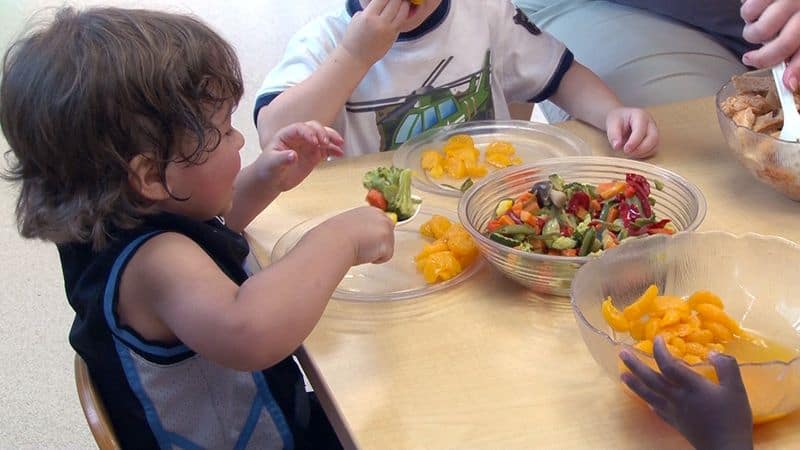Picky eating is a common challenge many parents face with their children. It can be frustrating when mealtimes turn into a battleground, with kids refusing to eat anything other than their favorite foods. Addressing picky eating requires patience, creativity, and a strategic approach to introduce variety into a child’s diet.
The key is to make mealtimes enjoyable and not a source of stress for both parents and children. By understanding the reasons behind picky eating and employing effective strategies, parents can help their children develop a more balanced and adventurous palate. Here are twelve tried-and-true methods to curb picky eating fast.
1. Introduce New Foods Slowly

Introducing new foods gradually can transform a picky eater into a more adventurous one. Start by offering small portions of new foods alongside their favorite dishes. This not only reduces pressure on the child but also makes the new food seem less intimidating. It’s crucial to maintain a positive and encouraging demeanor during meal times. Consistency is key, so keep introducing the same new food multiple times. It might take several tries before a child decides to taste it. Celebrate small victories to encourage them to try more new foods.
2. Make Meals Fun and Interactive

Turning meals into a fun and interactive experience can engage children and alleviate their reluctance to try new foods. Allow kids to participate in meal preparation, like arranging food into fun shapes or choosing their own toppings. This involvement can pique their interest and make them feel part of the process. Create themed dinners or allow them to play restaurant, where they ‘order’ from a menu that includes new food items. Enthusiasm is contagious; show excitement about trying new things and they might just join in.
3. Set a Good Example

Children often mimic the behaviors of adults. By setting a good example at meal times, parents can naturally encourage picky eaters to follow suit. When children see their parents enjoying a variety of foods, they may become curious and willing to try them too. It’s important to express genuine enjoyment and curiosity about different tastes and textures. Avoid displaying dislike for certain foods in front of the children. Through consistent modeling of positive eating habits, children can gradually develop similar attitudes towards food.
4. Use Creative Food Presentation

Creative food presentation can make a big difference in getting kids to try new foods. Arranging fruits and vegetables in fun shapes or colorful patterns can make them more appealing. You can create food art by making faces, animals, or scenes that attract a child’s interest. The visual appeal is often just as important as taste for children. Encourage them to make their own artistic plates, turning mealtime into a creative activity. This not only makes eating fun but also encourages them to try different foods in the process.
5. Avoid Using Food as a Reward

Using food as a reward can set up unhealthy associations and make picky eating worse. Instead of promising dessert for eating vegetables, emphasize balanced eating and the benefits of trying new foods. Encourage children to eat because it’s nutritious and good for them, not to earn a treat. Explain how different foods help their body grow and keep them healthy. By focusing on the intrinsic benefits of food, children can learn to appreciate variety without expecting a sweet reward for eating their meals.
6. Create a Relaxed Meal Environment

Creating a relaxed and stress-free meal environment can encourage children to enjoy eating and trying new foods. Eliminate distractions such as TV or gadgets to allow focus on the meal. Offer a calm atmosphere where everyone feels comfortable and conversation flows naturally. Avoid pressuring the child to eat or making negative comments about their eating habits. Instead, encourage and celebrate small steps towards trying new foods. A positive dining experience promotes better eating habits and reduces the anxiety associated with unfamiliar foods.
7. Involve Kids in Meal Planning

Involve children in meal planning to give them a sense of ownership and interest in what they eat. Take them shopping and let them pick out new foods to try, discussing different options and their benefits. This can also be an educational opportunity to talk about nutrition and healthy choices. When children feel included in decision-making, they’re more likely to try new things. Encourage them to suggest meals and help with simple meal prep. This involvement can foster a positive attitude towards food exploration.
8. Be Patient and Persistent

Patience and persistence are vital when dealing with picky eaters. It’s important not to give up if a child refuses a new food the first time. Repeated exposure, without pressure, can eventually lead to acceptance. Offer new foods regularly and in different forms, such as steamed, roasted, or raw. Keep the atmosphere positive and avoid showing frustration. Understand that taste preferences can change over time. Celebrate any willingness to try, even if they don’t like it right away. Persistence can slowly broaden their palate.
9. Encourage Self-Feeding

Encouraging self-feeding can turn mealtime into an enjoyable and exploratory activity for children. Allowing kids to feed themselves gives them a sense of independence and control over what they eat. Provide finger foods that are easy to handle and vary in texture and color. This hands-on experience can stimulate curiosity and willingness to try new foods. Avoid correcting their messiness; instead, focus on the fun of exploring new tastes and textures. By fostering a positive relationship with food early on, children can grow to be more adventurous eaters.
10. Limit Snack Options

Limiting snack options can regulate children’s appetite and encourage them to eat diverse meals. Offer two or three healthy choices for snacks, keeping away less nutritious alternatives. This limits the tendency to fill up on snack foods and leaves room for trying new things at meal times. Encourage a routine that includes scheduled snack and meal times, teaching children to expect variety in their diet. This practice helps in developing healthy eating patterns and reduces reliance on snacks to satisfy hunger.
11. Educate About Nutrition

Educating children about nutrition can empower them to make healthier food choices. Use age-appropriate materials like books or interactive games that explain the benefits of different food groups. Discuss how foods help them grow strong and healthy, using simple language they can understand. Making learning fun and relatable can spark interest in trying new foods. Encourage questions and exploration to make them feel involved in their nutritional journey. By understanding food benefits, children can become more open to trying varied foods.
12. Avoid Force-Feeding

Avoiding force-feeding is crucial for developing a healthy relationship with food. When children feel pressured to eat, it can create resistance and negative associations with food. Offer foods without insisting they be eaten. Allow the child to have some degree of control over how much and what they eat from what’s offered. Encourage tasting without forcing it, and model calm acceptance whether they choose to try or not. This approach helps maintain a positive atmosphere and encourages natural curiosity about food.

Well, hello there!
My name is Jennifer. Besides being an orthodontist, I am a mother to 3 playful boys. In this motherhood journey, I can say I will never know everything. That’s why I always strive to read a lot, and that’s why I started writing about all the smithereens I came across so that you can have everything in one place! Enjoy and stay positive; you’ve got this!

